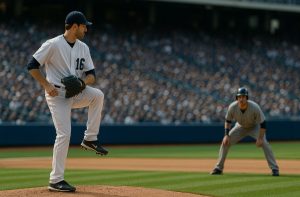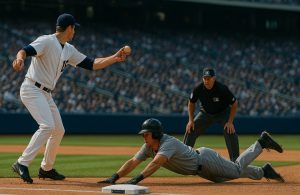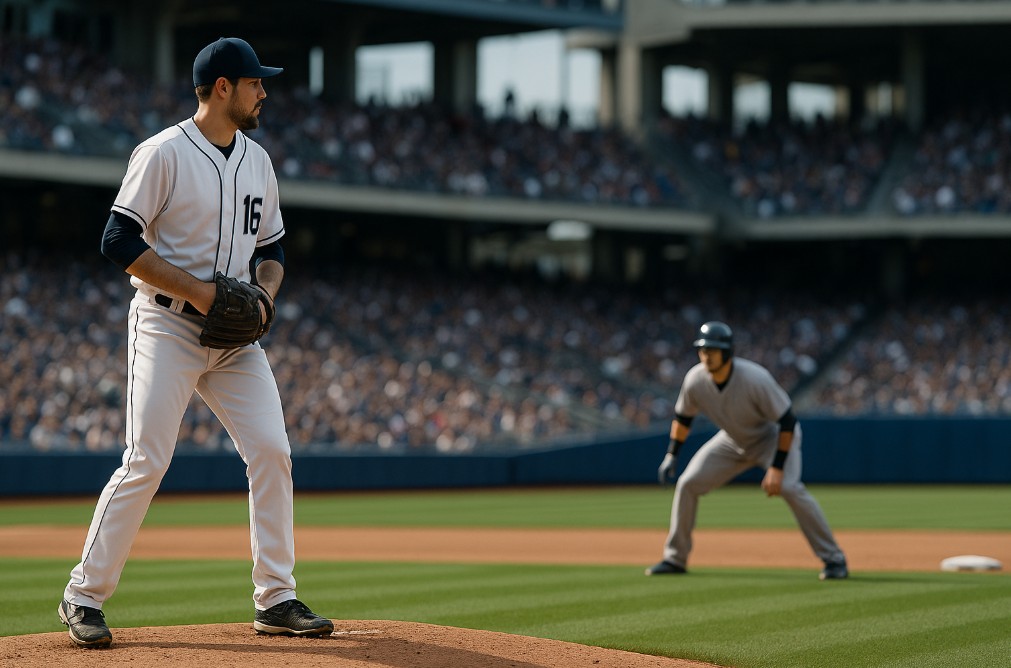What is a Disengagement in Baseball?
Have you ever watched a baseball game and seen a pitcher suddenly step off the mound or make a quick throw to first base? Did you wonder why that action mattered or why the umpire might call a balk after too many of those moves?
These moments are tied to one of Major League Baseball’s most recent and impactful rule changes: the disengagement rule.
The concept of a disengagement has become central to the way pitchers and runners battle on the base paths. It not only affects the pace of the game but also changes how pitchers approach strategy and how runners take advantage of their opportunities.
To fully understand the rule, it helps to break down exactly what a disengagement is, why MLB introduced it, and how it shapes the modern game.
What Does “Disengagement” Mean in Baseball?

In baseball, a disengagement refers to a pitcher stepping off the rubber or making a pickoff attempt toward a base. It even includes fake throws. Anytime a pitcher interrupts the rhythm of the pitch clock or tries to control the movements of a runner, it counts as a disengagement.
For example, if a pitcher feels the pitch timer is running low, he may step off to reset it. That reset is considered a disengagement. Likewise, when a pitcher throws to first base to keep a runner close or fakes a move to second, those actions are also recorded as disengagements.
This rule applies whether the pitcher is trying to stop the clock or simply to disrupt the runner’s timing.
What is the Official MLB Rule on Disengagements?
Major League Baseball currently limits pitchers to two disengagements per plate appearance when a runner is on base.
If a pitcher attempts a third disengagement without either recording an out or seeing the runner advance a base, the umpire rules it a balk. In that situation, the base runners automatically advance.
This limitation was introduced as part of the sweeping 2023 pace-of-play changes. Along with the pitch clock and larger bases, the disengagement rule was created to reduce stalling tactics and increase on-field action.
The idea is that by restricting pitchers from repeatedly stepping off or throwing to a base, the game moves faster and base runners are encouraged to be more aggressive.
Why Did MLB Introduce the Disengagement Rule?
Before the rule change, pitchers could make unlimited pickoff attempts or step off the mound as often as they liked. This often slowed the game and frustrated fans who wanted continuous action.
MLB saw this as a growing problem, especially at a time when the sport was trying to compete with faster-paced entertainment options.
By limiting disengagements, MLB tackled several goals at once. The rule prevents unnecessary delays, complements the newly implemented pitch clock, and encourages more offensive excitement.
With fewer pickoff moves allowed, runners are emboldened to take bigger leads, leading to more stolen base attempts and more plays that keep fans engaged.
What Actions Count as Disengagements in Baseball?
Not every move a pitcher makes counts as a disengagement, but the definition is broad enough to cover most interruptions of the pitching sequence. A disengagement occurs when:
- The pitcher steps off the rubber, even if it is simply to reset the pitch timer.
- The pitcher attempts a pickoff throw to a base.
- The pitcher fakes a throw to a base.
It is important to note that some situations do not count toward the disengagement limit. A mound visit by a coach or manager, for instance, is not considered a disengagement.
Similarly, if a runner advances during the plate appearance, the disengagement count resets, giving the pitcher two more opportunities under the new situation.
What Happens if a Pitcher Attempts a Third Disengagement?

The third disengagement rule is what gives the system its tension. If a pitcher attempts a third disengagement in the same plate appearance, it is automatically ruled a balk unless one of two things happens:
- The pitcher successfully records an out, such as picking off the runner.
- The runner advances a base during the play.
If neither condition is met, the balk penalty applies, and every runner on base is awarded the next base. This rule places significant pressure on pitchers who have already used two disengagements.
They must decide whether the risk of attempting another move is worth potentially giving runners a free advance.
When Does the Disengagement Limit Reset?
The disengagement limit is not locked for the entire at-bat. It resets if the game situation changes in certain ways.
For example, if a runner steals a base, advances on a wild pitch, or moves forward on a ground out, the pitcher regains the ability to make two more disengagements during that same plate appearance.
This reset is designed to keep the rule flexible while still preventing abuse.
How Do Disengagements Influence Pitcher and Runner Strategy?
The two-disengagement rule has created new layers of strategy on both sides of the ball. For pitchers, it requires more discipline. They can no longer casually throw over to first base multiple times just to rattle a runner. Every move must be considered carefully, because using disengagements too early may leave them exposed later in the at-bat.
Runners, by contrast, gain an advantage. Once a pitcher has used both disengagements, runners often extend their leads and prepare to steal. The knowledge that a third throw could result in a balk shifts the balance of power toward the offense.
The result has been a noticeable increase in stolen base attempts since the rule was adopted.
What Are Some Game Scenarios That Show How Disengagements Work?

Consider a pitcher facing a speedy runner on first base. He throws over twice to keep the runner honest. Now, with both disengagements used, the runner knows the pitcher must either risk a balk on a third throw or focus entirely on the batter.
This emboldens the runner to extend his lead and possibly attempt a steal.
Another common scenario occurs when the pitch clock is winding down. A pitcher might feel rushed and step off the mound to reset the timer. That decision buys him more time but also counts as a disengagement.
If he has already made a pickoff attempt earlier in the at-bat, that step-off leaves him with only one remaining opportunity.
A third example could involve a runner on second base. The pitcher fakes a throw to second, hoping to keep the runner close. Although no ball is thrown, the fake still counts as a disengagement.
These scenarios demonstrate the delicate balance pitchers must maintain between holding runners close and preserving their limited disengagements.
How Do Disengagement Rules Differ Across Baseball Levels?
At the professional level, both Major League Baseball and Minor League Baseball follow the two-disengagement system. The rule was originally tested in the minors before being fully adopted by MLB in 2023.
College baseball, however, does not yet have the same restriction. While the NCAA has experimented with pace-of-play rules, it has not implemented a formal disengagement limit.
In youth baseball, the rules are generally more relaxed. Coaches and leagues often prioritize teaching proper pitching mechanics rather than enforcing strict disengagement counts, though some advanced youth leagues may experiment with similar restrictions to prepare players for higher levels.
What is the Quick Reference for MLB’s Disengagement Rule?
| Situation | Rule | Outcome |
|---|---|---|
| First disengagement | Allowed | Runner remains in place |
| Second disengagement | Allowed | Runner usually increases lead |
| Third disengagement without out or advance | Illegal | Balk; runners advance one base |
| Runner advances during at-bat | Limit resets | Pitcher regains two disengagements |
| Mound visit | Not counted | Does not affect disengagement total |
Why Does the Disengagement Rule Matter in Modern Baseball?

The disengagement rule may appear to be a small technical adjustment, but it has fundamentally reshaped the rhythm and strategy of the game.
By restricting pitchers to two disengagements, MLB has reduced unnecessary delays, complemented the pitch clock, and created more dynamic opportunities for base runners.
The effect is evident in the increase in stolen bases since 2023 and the faster average game times. Fans now experience a more engaging product, with fewer pauses and more plays that keep the action moving.
For pitchers, it demands sharper decision-making. For runners, it creates a new window of opportunity. For the sport as a whole, it represents another step toward balancing tradition with the modern fan’s desire for excitement.
FAQs about Disengagements in Baseball
What counts as a disengagement in baseball?
A disengagement includes stepping off the rubber, making a pickoff attempt, or faking a throw to a base.
How many disengagements are pitchers allowed per plate appearance?
Pitchers are allowed two disengagements per plate appearance when runners are on base.
Do mound visits count as disengagements?
No, visits from coaches or managers are separate from disengagements.
What happens if a pitcher attempts a third disengagement?
Unless the pitcher records an out or the runner advances, a third disengagement is ruled a balk and base runners are awarded the next base.
Can pitchers reset the disengagement limit?
Yes, if a runner advances or an out is made during the plate appearance, the pitcher regains two disengagements under the new circumstances.
Why was the disengagement rule introduced?
It was implemented to speed up games, prevent stalling tactics, and increase base-stealing opportunities.
Are disengagement rules the same at all levels of baseball?
No, MLB and MiLB use the two-disengagement limit, but college and most youth leagues do not have the same restriction.


